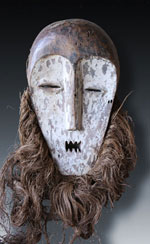African Art and El Anatsui
Africa is south of Europe.
In between the Atlantic and Indian Oceans.
More than 1,000 Languages have been identified.
The major religion that influenced Africa was Islam (done peacefully).
1914 under colonial rule
1945-1970s colonies gained independence one after another.
During the 20th century, the art of tradition African societies played a pivotal role in revitalizing the Western art tradition.
African Artifacts
African Art influenced furniture in the Art Deco time period. In some African cultures, elaborate stools or chairs were created not only to indicate their owners’ status but also to serve as alters for their souls after death. The example of the chair is from the Ngombe people who live along the Congo River. When France began to colonize Africa in the late 19th century and African objects were brought by French soldiers, administrators and adventurers.
Pierre Legrain. Tabouret, 1923
Homes and Dwellings
Nankani People create living spaces or dwellings in a cooperative but gender specific project.
Men build the structures and women decorate the surfaces. The dwellings are also gender specific the round dwellings are for women the square are for the men. (page 879 of Art History, Stokstad, second edition, volume 2) The dwellings or homes are a painted adobe architecture.
Children and Fertility Figures
Children are important in many cultures because they are what keeps that culture going; many children still die before age 5. Many women can not have children and are blamed for this, it’s rarely the man’s fault, the women carry fertility figures. Fertility figures are considered art.
Twin figures are important because if one twin dies the other twin is at risk.
These are Ibeji statues from the Yoruba people in Nigeria. They believe that twins share one soul. If one twin dies and goes to the spirit world, then the living twin is in danger. Mom has to go to a diviner and commission an Ibeji for her dead child. For the rest of her life, she must feed, take care of, make sacrifices to, and love the statue like her child. This keeps her dead child in the spirit world happy. This way, the living child’s soul remains intact.
Mom with her figures 1974
For babies that are born as multiple births (triples and such) Taiwo is the twin that sees the world first while Kehinde follows. Idowu is the child born after Kehinde, Alaba is born after Idowu and Igogbe is born after Alaba.
Spirits and Masks
Among the most potent images of power in African Art are the nkisi, or spirit, figures made by the Kongo and Songye people of the Congo.
Example of a Bwami Mask. source.
Kente {textile} Cloth
El Anatsui is a contemporary artist using this style with found/trash materials:
Anatsui was born in 1944. He is a Ghanaian sculptor active for much of his career in Nigeria. Anatsui was born in Anyako, and trained at the College of Art, University of Science and Technology, in Kumasi, in central Ghana. He began teaching at the University of Nigeria, Nsukka, in 1975, and has become affiliated with the Nsukka group. Some of his recent works resemble woven cloths such as kente cloth. Anatsui also incorporates uli and nsibidi into his works alongside Ghanaian motifs.
More Sources:
http://www.randafricanart.com/Yoruba_Customs_and_Beliefs_Pertaining_to_Twins.html
http://arthistory.wisc.edu/ah241/10.html
http://www.corbisimages.com/stock-photo/rights-managed/CT001177/nankani-woman-painting-a-hut
http://www.christies.com/LotFinder/lot_details.aspx?intObjectID=4005624
http://representingplace.wordpress.com/2010/03/10/el-anatsui-in-chelsea/
And that's my Artist of the week
Download my student's handout by clicking here.
http://www.randafricanart.com/Yoruba_Customs_and_Beliefs_Pertaining_to_Twins.html
http://arthistory.wisc.edu/ah241/10.html
http://www.corbisimages.com/stock-photo/rights-managed/CT001177/nankani-woman-painting-a-hut
http://www.christies.com/LotFinder/lot_details.aspx?intObjectID=4005624
http://representingplace.wordpress.com/2010/03/10/el-anatsui-in-chelsea/



.gif)







Wow this is fascinating!
ReplyDeleteI'm super interested in the housing of other cultures - specifically housing made primarily of earth.